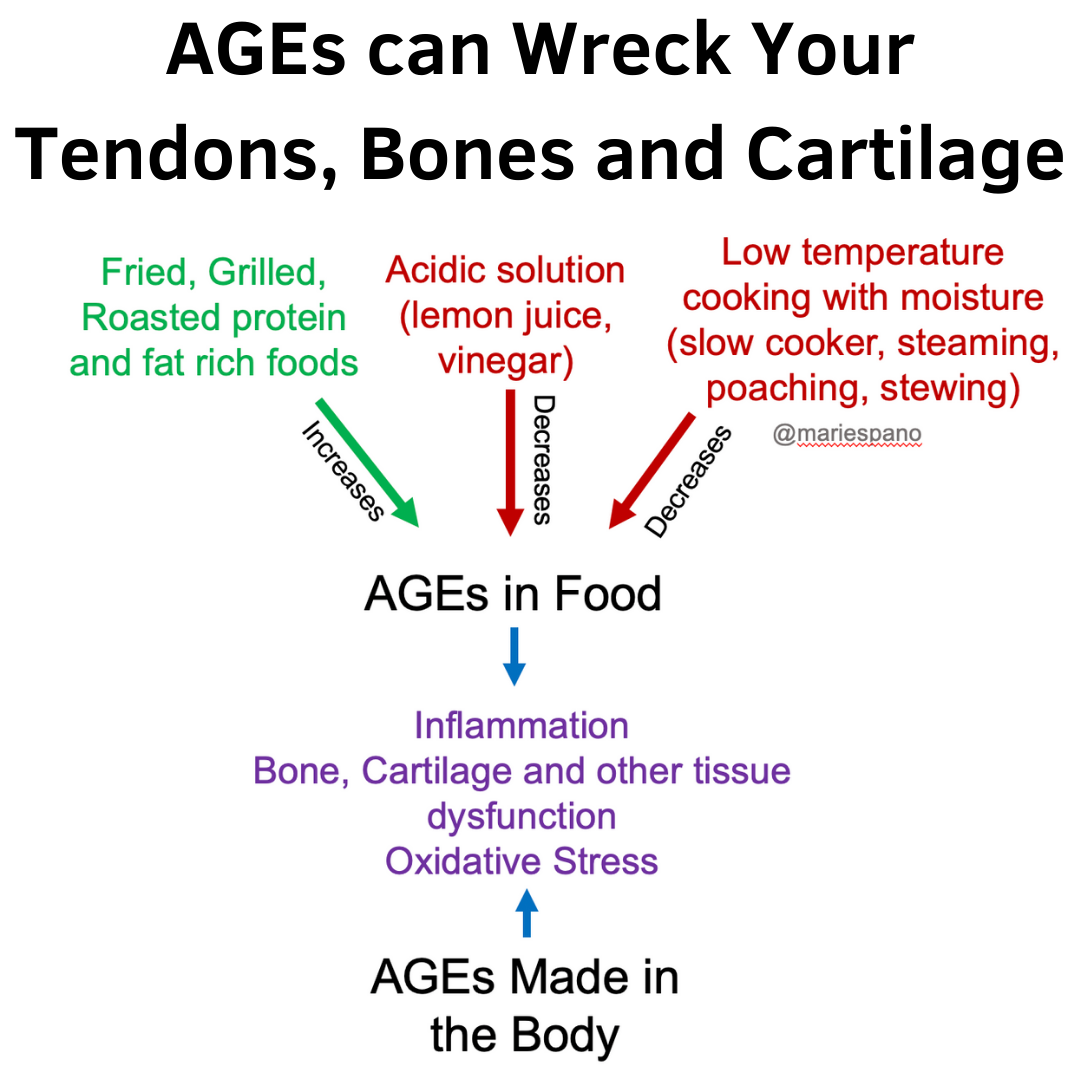AGEs (advanced glycation end products) can wreck your tendons, bones, cartilage and other tissues. Think of AGEs like a torch lighting your body on fire with inflammation and altering your body’s structures.
AGEs were a blip on the screen in Game Changers yet they weren’t discussed.

How do AGEs Accumulate in the Body?
-
- AGEs are complex compounds formed in food during processing; mainly when foods are heated. Protein and fat rich foods that are broiled, grilled, fried or roasted tend to be highest in AGEs. Low-fat, carbohydrate-rich foods including fruits, vegetables, milk and whole grains are relatively low in AGEs. (see below). We absorb about 10% of the AGEs from foods we eat. Research has not proven (and this would be hard to do) that dietary AGEs cause AGE accumulation in organs and tissues.
- Our bodies also produce AGEs (though these are structurally different and more homogenous than the AGEs in foods). High blood sugar, high blood lipids and oxidative stress can all increase AGE accumulation in the body.
How do AGEs Harm Your Body?
AGEs increase oxidative stress and inflammation in the body. Oxidative stress also increases AGEs in the body. AGEs accumulate in tissues including bones, joints and muscle and crosslink proteins (structures) in the body affecting their structure and function. They disrupt bone functioning and affect bone breakdown (a necessary process to get rid of older bone tissue) altering bone remodeling (the process of replacing old bone with new bone). AGEs also accumulate in cartilage (the cushioning between your joints) where they increase stiffness and accelerate cartilage breakdown. AGEs also alter cell signaling and gene expression.
About 2/3 of AGEs remain in the body for 3 days after you eat them. However, diet, AGE structures (the molecular weight) and the community in your gut influence the bioavailability of AGEs in the body. The average person consumes enough AGEs each day to turn on inflammatory pathways. If you eat a lot of fried, grilled or roasted meats, fats and processed foods you may be getting way more than the average person.
Decrease AGEs in the diet and inflammation, oxidative stress and endothelial (lining of blood vessels) dysfunction will decrease. A low AGE diet also improves insulin sensitivity in those with diabetes.
Decreasing AGEs
How do you decrease AGE formation? Cook food on low temperatures with high moisture (use a marinade) and expose them to an acidic solution (lemon juice or vinegar for example). Also, cook for as short of a period of time as possible. Boiling, steaming, poaching, stewing and using a slow cooker are the best cooking methods.
References
Bone 2002;31:1-7.
Osteoporos Int 2006;17:1514-23.
Proc Natl Acad Sci 2005;1043:474-81.
J Gerontol A Biol Med Sci 2007;62:427-33.
J Am Diet Assoc 2010;110:911-6.
Diabetes Care 2007 Oct; 30(10): 2579-2582.
Advances Nutr 2015;6(4): 461-473.
Nutr Metab 2018;15:72.
Ann NY Acad Sci 2005;1043:474-81.
Biochem Soc Trans 2003;31:1383-5.
Diabetes 1999;48:1308-15.
Proc Natl Acad Sci USA 1997;94:674-9.
Guilbaud A, Niquet-Leridon C, Boulanger E, Tessier FJ. Foods 2016;5, 84.